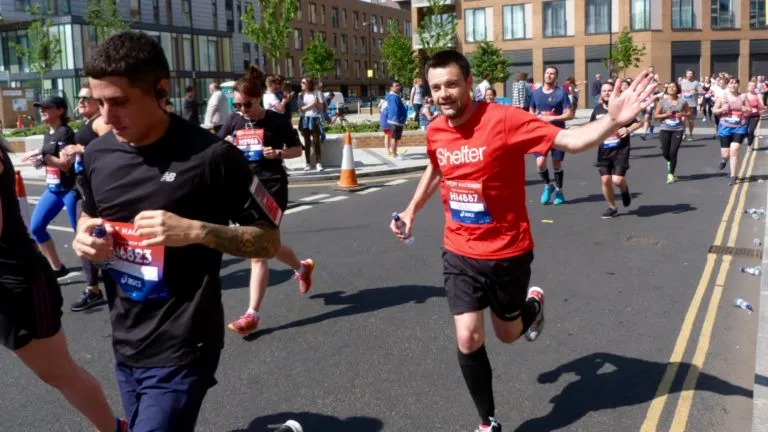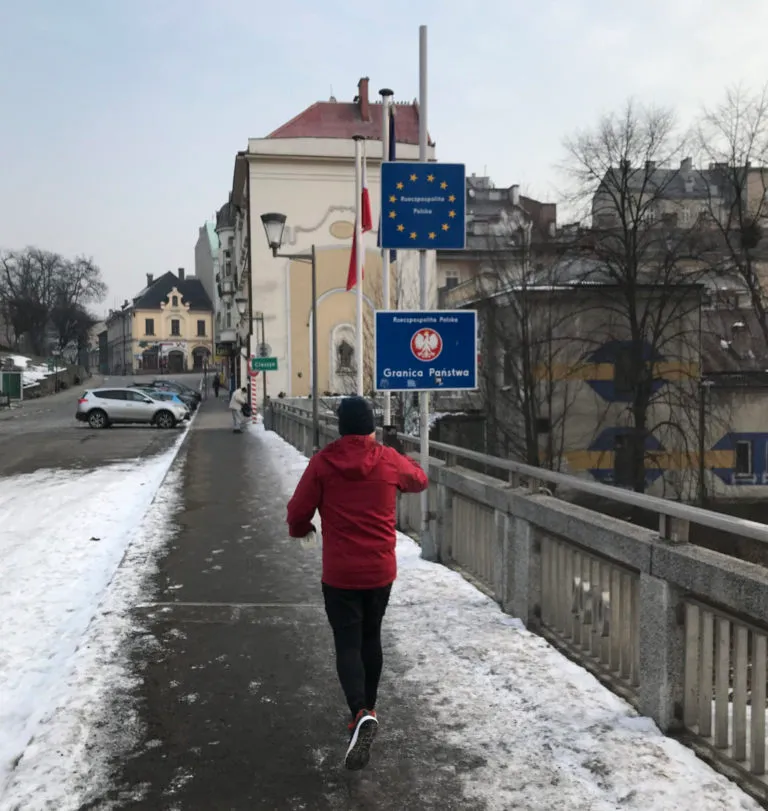13.1 things to know about running a charity half marathon for the first time
Published: by Becky Brynolf

We’re delighted to bring you this guest blog from Glen, who recently took on the Hackney Half Marathon for Shelter.
A half marathon isn’t easy. That’s not even one of the 13.1 things for you to know. No, that’s just some straight-up complimentary truth to kick things off. If you’re not a runner, this is going to be hard work. But that’s the point – because you find running far to be plain-sailing, then you won’t get any sponsors. Your friends may be supportive, but they’re not mugs.
So, it’s hard, but not impossible. I am very much not a runner. The day before I started training to do a half marathon for Shelter, I had to stop for a breather during a fifty-yard jog to catch a train. The previous week I got cramp from sitting on a bar stool. At that point, as I shrieked and hobbled between confused pub regulars, the prospect of running 13.1 miles looked somewhat far-fetched.
But I went and bloody managed it. And if I can, you can! So on behalf of Shelter, I’ve put this guide together to try to help you along. And because I’m not a runner, this isn’t expert advice – nor a definitive guide or jargon-riddled athlete’s manual. It’s just some stuff I learned whilst trying to run a long way that hopefully might help someone else take up the challenge, and raise a big fat wedge of money for a deserving cause.
1. The first training run is the hardest
Getting up, getting out and going for a run is not simple. If it was, you’d have done it before. But it really doesn’t matter how far or fast you go – or what you look like. And you might even discover you’re incredible at it (I mean, you probably won’t, but you can’t know for certain until you give it a bash). Still, whether you manage to run for five minutes or fifteen before you’re out of breath, and can’t go on doesn’t matter – the important thing is you get out there. You will feel incredibly satisfied once you do, and it will also give you something to build on; helping you know where your ability lies before you start training.
2. …but the second one hurts more
Following up your first hit is always going to be hard. Just ask Chesney Hawkes. The day after my first training run, I could barely get down the stairs from my flat – and I only live on the first floor. It will be tempting to wait until these aches have disappeared before you try your second run. But if you keep doing that, your muscles will never get used to you running. So you need to push through. And it will hurt – quite a lot. But if you keep getting out there, it will never hurt this much again.
3. You don’t need all the gear
Running is not a complicated sport, so don’t make it one. Yes there is a world of specialised running kit and gadgets out there, but just because they exist doesn’t mean they’re essential – that’s why you don’t own a Bluetooth-activated toilet seat. Downloading an app which accurately measures your pace and the distance you’ve run is useful – and plenty of free ones that do this, but you really won’t need more than that.
4. Music is a useful distraction
I found listening to a playlist of some of my favourite music helped the kilometres go by easier, and also made for a much more enjoyable soundtrack than my clicking ankle joints and increasingly heavy breathing. However, in a not unrelated learning, dog-walkers will look at you oddly if you lumber past them air-guitaring the opening to Beastie Boys’ ‘Sabotage’.
5. Try not to leave any unknowns
I deliberately chose the Hackney Half Marathon because it’s a pretty flat course. But if you don’t have the luxury of a hill-free half marathon, then make sure you incorporate some inclines in your training runs. It’s much better to discover hills are hard before the day of the event. For the same reason, try to run in all weather before race day too.
6. Seize the little wins
You’re in this for the long haul, so it’s important to seize the wins and make the most of the positives. I got a fist bump and some words of encouragement from a stranger in Ladywell Fields on one of my early runs – and it made me feel brilliant! So seize those little boosts, and be sure to congratulate or even reward yourself each time you run further than you’ve run before.
7. Remember that distance and duration are what matter
You will not win your first half marathon. Sorry to break it to you so bluntly. But sadly, this isn’t a Hollywood movie – if it were, I could’ve just suggested you nail an inspirational training montage and we could’ve clocked off back at point one. No it’s real life, and here in the UK we don’t aim to win real life – we just aim to get through it without falling over or choking on a jelly baby. Same with half marathons. So you don’t need to worry about running quicker, you just need to focus on running farther and running for longer.
8. Mix up your route
Running roughly the same route and adding a bit more on each time is helpful for measuring your progress – but will also get quite dull. So try different routes every once in a while to keep things interesting. And if you go away for a few days, take your running kit. Much as I love the streets of Lewisham, breaking them up with the Cornish coast, the Derwent Valley and even a run across the Czech-Polish border kept me motivated.

9. Some days will be better than others
If you’re sticking to a realistic and regular training plan, most of the time you’ll find yourself making progress. But not every time. I had some really awful training runs – I had to abandon two, and make a two-mile sombre trudge home like Charlie Brown. The important thing is not to beat yourself up. Don’t let it stop you going out on your next run.
10. People will overtake you
…and that’s fine. You’re not in a hurry, and other people are better at running than you are. You’re not trying to beat anyone – you’re just trying to run a long way, vaguely comfortably. So wave them past and stick at your own pace (then swear about them under your breath).
11. Don’t forget why you’re doing it
There was an evening in late February, when snow was falling and the temperature hadn’t made it above freezing in three days. I didn’t fancy running in that. But then on my commute home, I passed two people who were sleeping rough. If you’re running to help the fight against bad housing and homelessness, you can’t really use bad weather as an excuse not to get out there. If people can endure sleeping in it, surely you can whack on some extra layers and manage half hour running in it. And as I said in the introduction, this isn’t meant to be easy.
12. Nipple-chafing is a thing
…as I discovered after a long Sunday run in the rain. I’d go so far as to rate it as one of the most painful of all the potential chafing. Plasters help – but if, like me, you don’t much fancy waxing two neat little rectangles into your chest hair, so does skin cream or Vaseline.
13. Run it your way
All the expert guides I read encouraged reducing training in the weeks before the event, but with seven days to go I was really worried I wouldn’t be able to go the distance. So I went for my longest run yet. And I managed it. And I instantly felt much more confident and much less anxious about making it through the half marathon. I’m not saying you should do this. You probably shouldn’t. But this is your challenge, and you know you better than anyone else. So, while you should always adhere to the training advice of professionals over some chancer like me, I will say that it is important to run and prepare for it in a way that suits you.
So, those are some of the things I learned whilst preparing to run a half marathon for Shelter. Did I mention how hard it is? I think I did. Thankfully though it all came together, so here’s an extra thing you should know that I found out the hard way upon completing the run.
13.1 Not every gel you’re given on race day is edible
Proper runners probably know the difference between caffeine gel and joint relief gel instinctively, but when you’ve just run 13.1 miles for the first time and you’re tired and emotional, it isn’t so obvious. Make sure you read the label, because if you think the caffeine gels offer little in the way of a taste sensation, well…
Glen is a writer and editor, and you can find him on Twitter. If he’s inspired you to find your first or even next half marathon, why not join Team Shelter for this year’s London Landmarks Half? We’d love to have you!